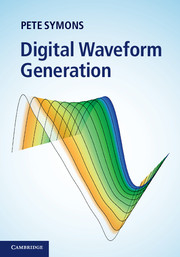Book contents
- Frontmatter
- Contents
- Preface
- Acknowledgements
- Glossary of terms
- 1 Introduction to waveform generation
- 2 The foundations of digital waveform generation
- 3 Recursive sine wave oscillators
- 4 DDS sine wave generation
- 5 DDS arbitrary waveform generation
- 6 Dynamic waveshape and spectrum control
- 7 Phase domain processing – DDS and the IDFT
- 8 Hardware implementation architectures
- 9 Digital to analogue conversion
- Index
Preface
Published online by Cambridge University Press: 05 November 2013
- Frontmatter
- Contents
- Preface
- Acknowledgements
- Glossary of terms
- 1 Introduction to waveform generation
- 2 The foundations of digital waveform generation
- 3 Recursive sine wave oscillators
- 4 DDS sine wave generation
- 5 DDS arbitrary waveform generation
- 6 Dynamic waveshape and spectrum control
- 7 Phase domain processing – DDS and the IDFT
- 8 Hardware implementation architectures
- 9 Digital to analogue conversion
- Index
Summary
Most electronic design engineers, irrespective of being the ‘analogue’ or ‘digital’ variety, are occasionally faced with the task of designing an oscillatory signal generator with particular implementation constraints, control and performance requirements. These requirements might include extremely low distortion, unusual ‘application specific’ waveshape, wide frequency tuning range, low temperature drift, and so on. Historically, such a task will have been tackled with a wholly analogue design, possibly augmented by digital control, where extremely high levels of performance are evident in some cases. If we take high-end audio test instrumentation as an example, the now legendary Hewlett Packard HP8903B and Audio Precision AP1 audio test sets both use digitally controlled analogue state variable oscillators to generate extremely low distortion sine waves. The state variable analogue oscillator is effectively an analogue computer model designed to compute solutions of a second-order differential equation. A specific class of solution (under certain parametric conditions) is a continuous sinusoidal oscillation. These generators are outstanding examples of what can be achieved with innovative analogue design. However, the world is becoming increasingly digital and very high levels of digital processing power can be implemented at relatively low cost. Various ‘all digital’ waveform generation techniques are therefore now practicable; and when all of their advantages are weighed up against the disadvantages (yes, digital processing is not necessarily a panacea to guarantee ideal performance), they nearly always represent the best solution. This approach is reinforced, if not driven, by the ever-improving performance of commercial digital to analogue conversion (DAC) devices as measured by their spurious-free dynamic range (i.e. distortion) and bandwidth. It is not unreasonable to state that the integrated DAC is the foremost enabling technology for nearly all applications of digital waveform generation. Exceptions to this observation apply to purely digital signals, which exist as a discrete-time sequence of binary numbers representing the signal waveform samples.
- Type
- Chapter
- Information
- Digital Waveform Generation , pp. xi - xvPublisher: Cambridge University PressPrint publication year: 2013

